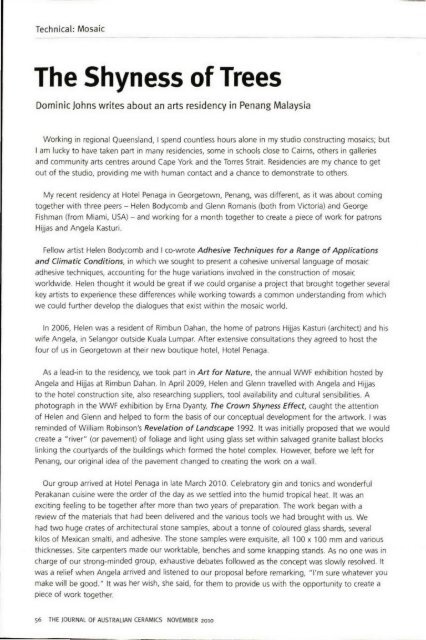The Journal of Australian Ceramics Vol 49 No 3 November 2010
Create successful ePaper yourself
Turn your PDF publications into a flip-book with our unique Google optimized e-Paper software.
Technical: Mosaic<br />
WOlklng on the panels at the Butter Faaory Ans Centre workshop; photo: Jennifer Sadler<br />
<strong>The</strong> Making Process<br />
This approach to mosaic is entirely different to the style <strong>of</strong> mosaic where small tesserae are used to<br />
build up the design. Cutting the design into s<strong>of</strong>t clay has great appeal as a contrast to working with<br />
hammers and tile nippers. I enjoy both techniques and they can be combined to great effect. Careful<br />
consideration must be given to break up the design into workable segments. This influences the design<br />
itself. Shrinkage <strong>of</strong> the clay during drying and firing automatically creates grout spaces. We also allowed<br />
for 10% shrinkage. Backing boards were not cut until all tiles had been fired.<br />
<strong>The</strong> full size design was drawn up onto clear plastic with a permanent marker, using metho to wipe<br />
<strong>of</strong>f any mistakes. Clay was rolled to about 1 cm and left to rest before cutting. Working with 's<strong>of</strong>t<br />
leather hard' clay gave the best results. <strong>The</strong> design was transferred through the plastic by scribing with a<br />
pencil or ballpoint pen . Tiles were cut out and numbered to match the design - this was very important<br />
because the tiles are handled and moved many times, especially in a group situation!<br />
Tiles can be textured, incised and stamped using natural and man-made materials. In this project<br />
an old farm fencepost was used to create tree textures. One group member supplied a remnant <strong>of</strong><br />
her wedding dress lace to texture the mountain. (This created a beautiful link to the grandma story.)<br />
Relief areas were built up in some places. <strong>The</strong> tiles were dried very slowly between boards to eliminate<br />
warping.<br />
Walkers BRS (Buff Raku with Sand) was used for this project, with white earthenware decorating slip<br />
applied to some areas. Text elements were hand painted onto individual tiles using black underglaze.<br />
Tiles were bisque-fired to 1000°C. Oxide washes were used in various combinations to produce an<br />
earthy palette <strong>of</strong> colours and Deco underglaze colours were also used in some areas. Mal made a<br />
'mystery' metallic glaze for the saw blades and axe head. A brush-on clear mid-fire glaze was then<br />
applied and all tiles were fired to 1200°C.<br />
Backing boards were cut from 6 mm compressed fibre cement sheeting sealed on both sides with<br />
S4 THE JOURNAL OF AUSTRALIAN CERAMICS NOVEMBER <strong>2010</strong>


















